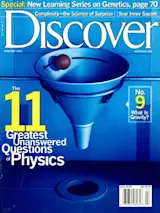The odds that scientists will someday be able to detect life elsewhere in the universe got a little better in December, when astronomers made the first measurement of the composition of a planet outside our solar system.
The alien world, a gas ball similar to Jupiter, circles in a tight three-and-a-half-day orbit around the yellow star HD209458, located 150 light-years away in the constellation Pegasus. By good fortune we see the planet's orbit edge-on, so every three and a half days it appears to pass in front of its star. Two years ago David Charbonneau of Caltech spotted one of these mini-eclipses, technically known as a transit. Then in May 2000 he and his colleagues trained the Hubble Space Telescope on HD209458 during four more transits. This time they looked at a narrow band of the star's spectrum for signs that its light had been absorbed by sodium atoms in the planet's atmosphere. "Sodium is not particularly abundant in the atmosphere, but it's very effective at absorbing light. It makes a large target," Charbonneau says.
As they had hoped, the researchers found a specific blip in the star's spectrum during a transit, indicating that the distant planet contains sodium—and confirming it possesses an atmosphere. Charbonneau will soon look for the chemical signatures of potassium and lithium and eventually for biologically important molecules such as water vapor and methane. Oxygen isn't likely in this planet's searing 2,000-degree-Fahrenheit atmosphere, but Charbonneau and his colleagues plan to search for other planets that may also be seen silhouetted against their stars. The technique offers promise that if astronomers someday locate a smaller, more hospitable world, they'll know exactly how to look for signs of oxygen in its atmosphere.














